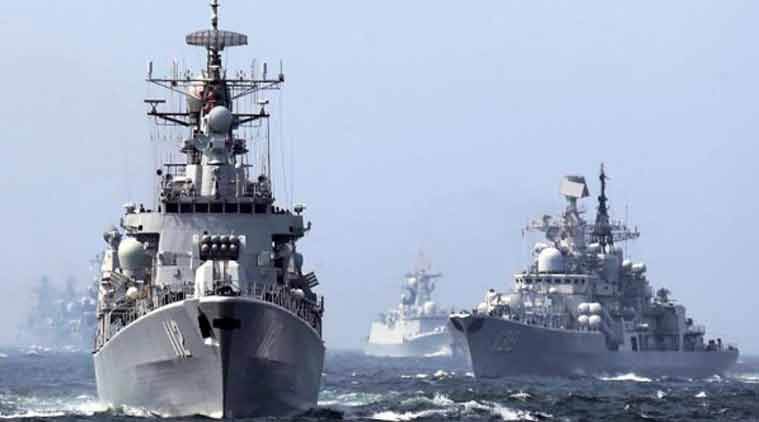
SOURCE: ENS
The recent re-emergence of terms like “Malabar” and “Quad” in the media, as well as in the national security discourse should be music to the ears of India’s small but diehard band of “navalists” (advocates of maritime power), who had not long ago heard disheartening public pronouncements that since the Indian armed forces were not “expeditionary forces” — for global deployment — they must confine themselves to “guard and fight” only along national borders.
It is essential for India’s strategic-planners and policy-makers to retain clarity about the reason India has become a partner that is sought after by the US and others. While India’s status as a nuclear-weapon state and major land/air power, as well as a growing economy and attractive market, has been known for some time, New Delhi’s newfound allure for the US, the Quad and ASEAN is rooted only in its ability to project power and influence in distant ocean reaches.
In the current scenario, given Chinese intransigence and our misreading of their imperialist-expansionist intent, Sino-Indian tensions are likely to persist. If India is not to cede ground physically or diplomatically, it must muster all elements of its “comprehensive national power”, including the maritime, and create a strong negotiating position. Apart from the balance of forces on land favouring China, there is also the Beijing-Islamabad Axis that awaits activation. Keeping tensions confined to the Himalayan arena is, therefore, not only militarily advantageous to China but a continental focus also helps to keep India contained in a “South-Asia box”.
To the navalists, this seems all the more reason for India to try shifting the confrontation to “sea-level”, where the asymmetry is in its favour. In this context, if Exercise Malabar and the Quadrilateral concept are at long last going to be leveraged to make common cause in the maritime domain, the provenance of both needs to be seen in perspective.
When America first reached out to India in the early 1990s to offer military-to-military cooperation, the Indian Navy (IN), keen to shed its Cold War insularity, responded eagerly. It initiated the first-ever naval-drills with the US Navy (USN) in May 1992. Code-named Malabar, the annual exercise got off to a good start and with a brief interruption during the post-Shakti sanctions saw its 24th edition in 2019.
China has remained bitterly opposed to Malabar because it saw the growing relationship as India’s first step on the American bandwagon. Consequently, when Malabar-2007 was enlarged to accommodate Australia, Singapore and Japan, China sent a diplomatic protest conveying its fear and displeasure. It took another eight years before Japan was formally admitted to make Malabar a tri-lateral event in 2015.
The Quadrilateral traces its origins to the great Asian tsunami of December 26, 2004. IN ships, aircraft and helicopters were despatched within hours to render assistance to our Sri Lankan, Maldivian and Indonesian neighbours in distress. This swift response established our navy’s credentials as a credible regional force and the following day the Commander US Pacific Fleet sought our concurrence, telephonically, for his units to join the rescue effort. Within a week, the navies of the US, Australia Japan and India had come together to form “Joint Task Force-536” headquartered in Utapao (Thailand). This established the framework for “quadrilateral coordination”.
It is noteworthy that not a single PLA Navy (PLAN) ship was seen throughout the 2004 tsunami relief operations. But, as mentioned earlier, when navies of five nations assembled for a joint exercise off Okinawa, China issued a demarche to India, US, Japan and Australia seeking details about their meeting — terming it a “Quadrilateral initiative”. China’s extreme concern about the concepts of Malabar as well as the Indo-Pacific and Quad arises from the suspicion that they are precursors to “containment” — the Cold War geopolitical strategy used by the US to isolate and engineer the collapse of the USSR.
China’s hostility arouses trepidation amongst Quad members and a degree of equivocation is evident in their actions and articulations. As early as 2008, Australian Prime Minister Kevin Rudd decided to dump the Quad to pander to China’s wishes. PM Narendra Modi, in his speech at the Shangri La Dialogue 2018, sought to reassure Beijing by stating: “India does not see the Indo-Pacific as a strategy… and by no means do we consider it as directed against any country…”
The time for ambivalence is over and while India will have to fight its own territorial battles with determination, this is the moment to seek external balancing. A formal revival and re-invigoration of the Quad is called for. It is also time to seek an enlargement of this grouping into a partnership of the like-minded. Other nations feeling the brunt of Chinese brawn may be willing to join an “Indo-Pacific concord” to maintain peace and tranquillity and to ensure observance of the UN Law of the Seas. News of Australia being re-invited to participate in the Quad deserves a conditional welcome, given Canberra’s past inconsistency and political flip-flops.
While Malabar remains a visible and reassuring symbol of Indo-US-Japanese solidarity, there is a need for the US to recast, along with partners, its Indo-Pacific strategy, which has had no impact on China’s unfolding hegemonic master-plan. In this context, Secretary of State Mike Pompeo’s bombastic statement earlier this month regarding China’s maritime claims — far from conveying reassurance — served only to highlight America’s helplessness in the South China Sea. Having failed to deter China from creating and fortifying artificial islands in open defiance of the UN Tribunal’s verdict, all that the US has been able to demonstrate is the hollow symbolism of US warships conducting “freedom of navigation” sailings through Chinese-claimed waters.
The US must also note that as the Chinese juggernaut continues to roll westwards, should Iran abandon India for China as a partner in the Chabahar port deal, it would represent yet another huge gain for China. The PLAN may now have not just Djibouti but also Gwadar and Chabahar as maritime footholds in India’s Arabian Sea neighbourhood.






